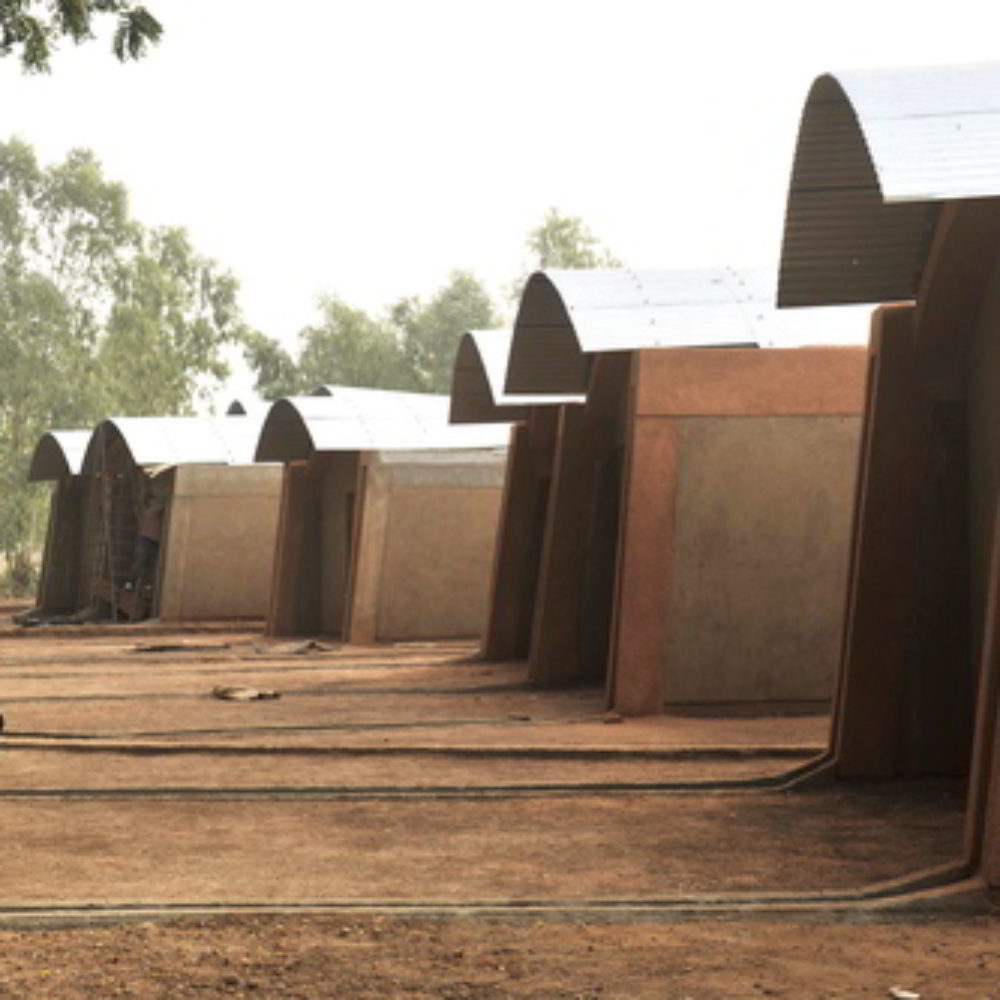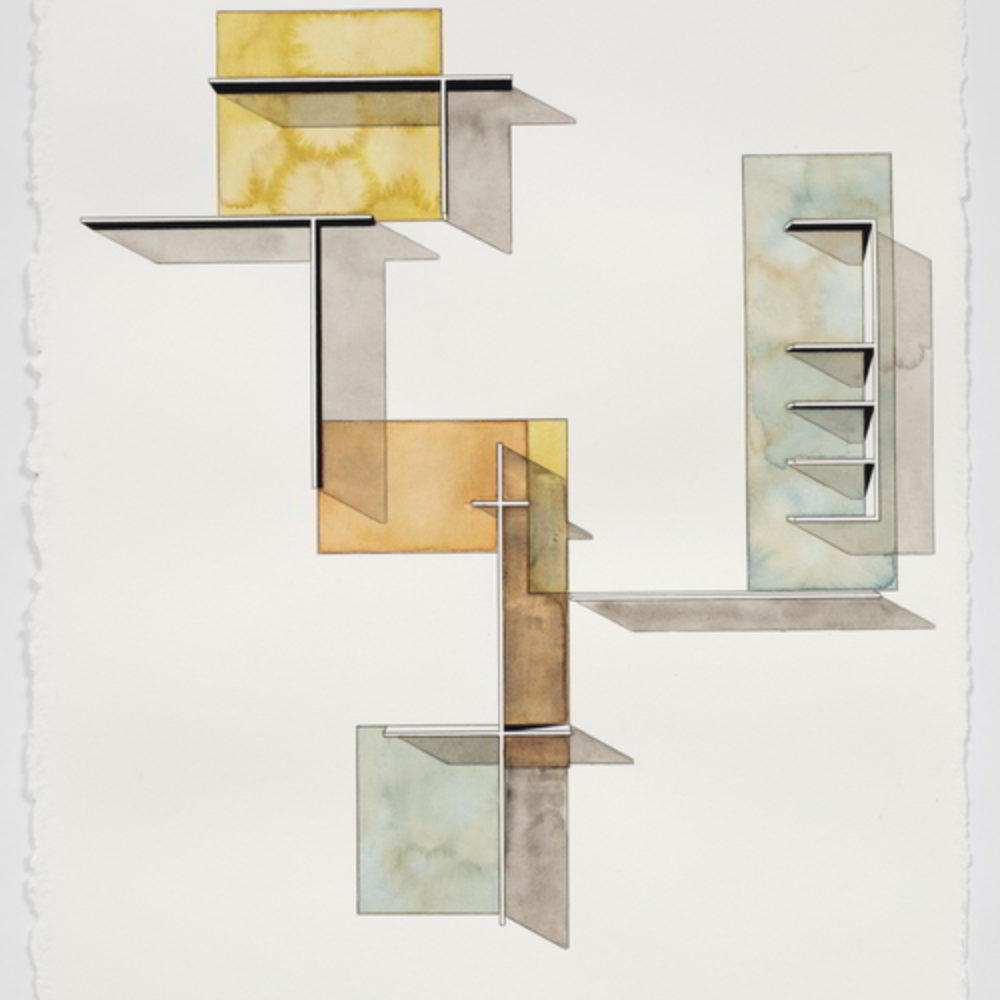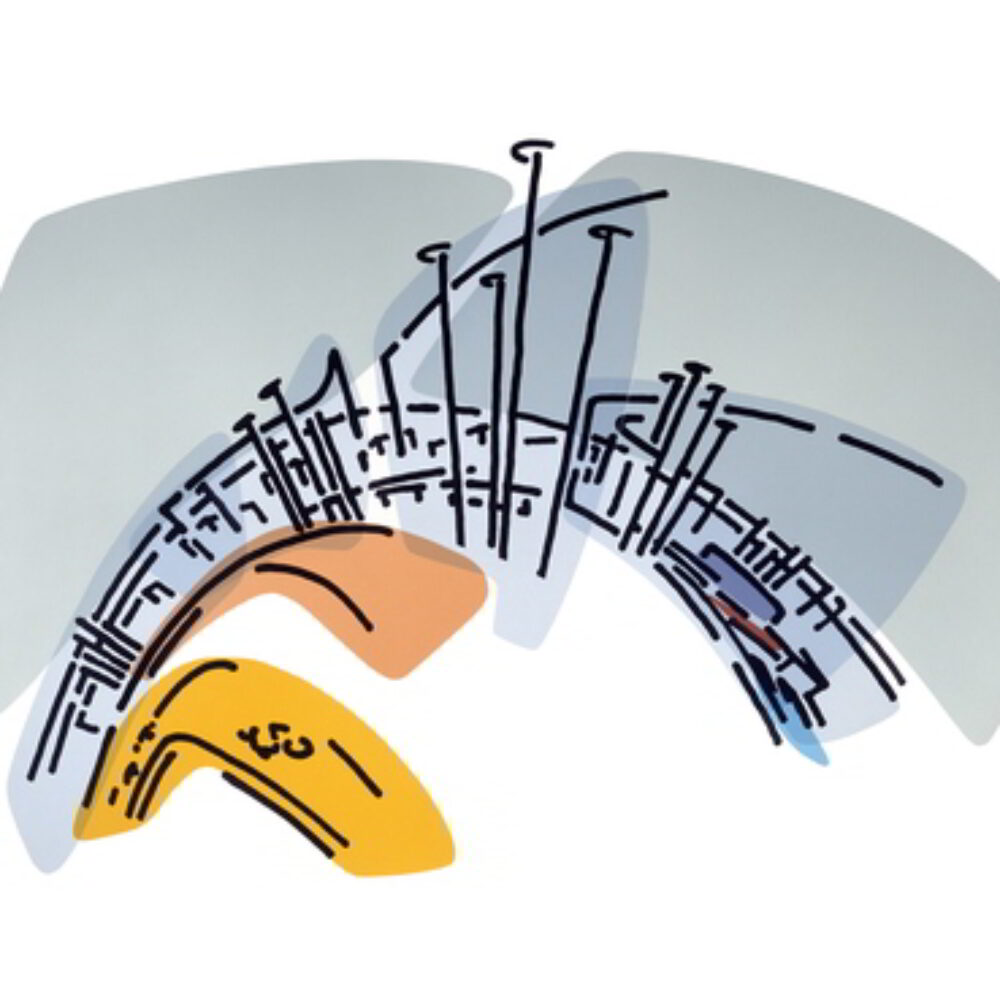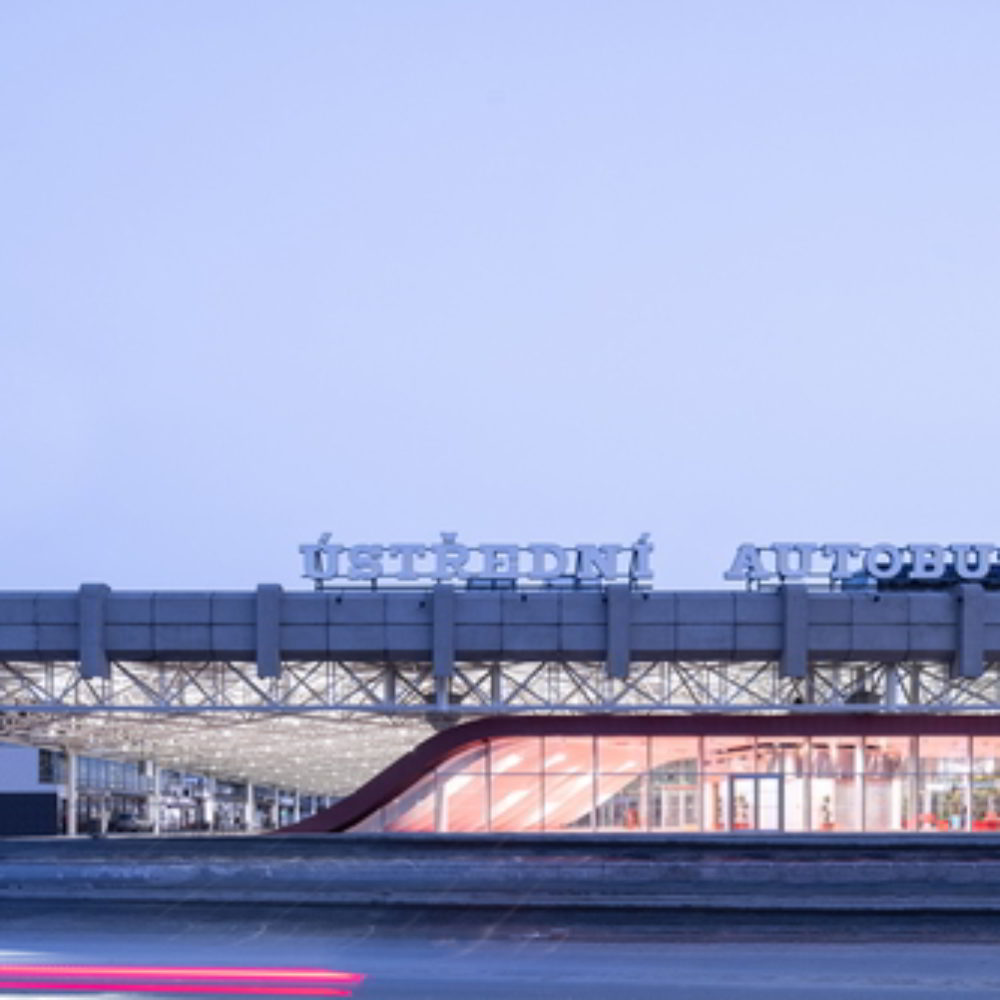Das Thema der aktuellen Ausstellung von Yadegar Asisi im Panometer Leipzig ist wie gewohnt überwältigend: NEW YORK 9/11 – Krieg in Zeiten von Frieden. Dazu spricht der Künstler von Hintergründen und Details, erzählt von seinem Werdegang und stellt die Frage, warum wir heute so abgebrüht sind.
15. März 2023 | Özlem Özdemir
Özlem Özdemir: Ihre Panorama-Themen kreisen oft um dunklere Momente der Menschheit. Da sind Schlachten, Umweltbedrohungen, Katastrophen oder andere historische Einschnitte wie bei Leipzig 1813, Luther 1517 und Titanic. New York 9/11 – Krieg in Zeiten von Frieden, die aktuelle Ausstellung im Panometer Leipzig, behandelt die Anschläge vom 11. September 2001 auf das World Trade Center und ihre globalen Auswirkungen. Bevorzugen Sie das Große und Gewichtige, um Ihre Panoramen überzeugender und verlockender für das Publikum zu machen, oder gibt es andere Gründe?
Yadegar Asisi: Viele, die ein Panorama noch nicht gesehen haben, denken, das Große ist das, was überwältigt. Aber nein, das Große verliert sich innerhalb von Minuten. Als ich mich erstmals mit dem Thema Panorama befasste, wusste ich nicht, auf was ich mich einlasse. Ich hätte nie gedacht, dass es eine solche Möglichkeit gibt, die wie auf mich zugeschnitten ist. Das hat sich so entwickelt und so auch die Themen. Ein gutes Beispiel ist der Erfolg mit Everest. Bei diesem Projekt hatte ich den fast kindischen Ansatz „der größte Berg der Welt braucht das größte Panorama“. Es wurde dann das erste Großpanorama.
Dies führte zum Gedanken, das Panorama in seiner Ganzheit noch mal aufzulegen und sich mit der Frage auseinanderzusetzen: Was kann es eigentlich heute bewirken? Ich habe mich einige Monate eingeschlossen und Themen gesucht, die mich besonders interessieren. Da ging es nicht um das Große, sondern das Werden und Vergehen dieser Welt. Es geht um die Betrachtung des Menschen in Beziehung zu dieser Welt.
ÖÖ: Also Ihre Themen entstehen nicht spontan oder fliegen auf Sie zu, sondern Sie haben von Frühbeginn an darüber reflektiert, was Ihr Themenkreis sein soll?
YA: Ja. Durch meine Überlegungen kam ich zu vier Hauptthemen. Stadtansichten, die meist nicht nur die Stadt selbst, sondern den Ort im Kontext der jeweiligen Gesellschaft darstellen. Zeitgeschichtliche Arbeiten, also Bilder des kollektiven Gedächtnisses. Dann die Naturbilder, die die emotionale Kraft von Naturräumen zeigen. Und schließlich das Panorama als Wahrnehmungsobjekt, das ausschließlich für sich steht. Ich erweitere das Programm ständig. Bei der Wahl meiner Themen verlasse ich mich sehr auf mein Gefühl.
ÖÖ: Sie haben Malerei studiert und waren Meisterschüler von Professor Klaus Fußmann, ein bekannter Landschaftsmaler und Vertreter der Neuen Gegenständlichkeit. Von ihm stammt das Deckengemälde Wolkenzug im Spiegelsaal des Hamburger Kunstgewerbemuseums. Inwieweit war Fußmann wichtig für Sie?
YA: Von 1973 bis 1975 studierte ich in Dresden Architektur und hatte ein Architekturbüro. Weil es damals in der BRD als Studienabsolvent keine Aufenthaltserlaubnis gab, studierte ich im Anschluss noch Malerei. [Asisi, Sohn persischer Eltern, wurde während der Flucht seiner Mutter aus dem Iran nach Europa in Wien geboren. Sein Vater, ein kommunistischer Offizier, wurde vom Schah zum Tode verurteilt. Seine Kindheit und Schulzeit verbrachte er in Halle (Saale) und Leipzig. 1978, als er sein Architekturstudium beendet hatte, wurde er aufgefordert, innerhalb eines Monats aus der DDR auszureisen. Da er aber auch nicht in den Iran durfte, wollte er nach West-Berlin. An der Grenze inhaftierte man ihn mit der Beschuldigung der illegalen Einreise mit persischem Pass. Bleiben konnte er nur als Student. So kam es zum Malereistudium an der Hochschule der Künste in Berlin; Anm. d. V.] Das Malereistudium war mir als Horizontgeber sehr wichtig. Dadurch kam ich zu Fußmann. Als Maler gefiel er mir schon immer. Er hat mir Sätze mit auf den Weg gegeben, die für mich sehr, sehr wichtig waren.
Vor Kurzem habe ich Fußmann durch zwei Panoramen geführt. Er sagte mir, dass ich einer der Studenten war, der ihm sehr in Erinnerung geblieben ist. Es faszinierte ihn, wie ich meinen Weg gehe. Er hat seine Malerei immer durchgesetzt – unabhängig von Galerien. Denn die hätten ihn anfangs nur Stillleben malen lassen, weil sich das gut verkauft. Aber er wollte immer die Landschaft, das Figürliche, und das hat er sich nicht nehmen lassen.
Auch für mich war es sehr wichtig, einen unabhängigen Weg zu finden. Dass das gelungen ist, ist eine großartige Fügung. Klaus Fußmann war für meine Entwicklung eine tolle Begegnung. Sein Ansatz als Maler hat mir immer ungeheuer gut gefallen und unsere Gespräche waren mir wertvoll. Ich hoffe, dass er noch lange lebt. Genauso war es eine gute Fügung, dass ich in der Architektur gelandet bin, denn letztendlich hat mich das Zusammenspiel zwischen Architektur und Malerei dahin gebracht, wo ich jetzt bin. Ich will beides nicht missen.
ÖÖ: Apropos Architektur: 1982 erhielt Ihr Büro Brandt-Asisi-Böttcher einen Mies-van-der-Rohe-Preis für den Kopfbahnhof der Berliner Magnetbahn. Ein paar Worte zu Andreas Brandt: Seine Arbeit war geprägt vom Reisen und Zeichnen und beides ist auch für Ihr Werk sehr wichtig. So reisten Sie für Pergamon in die Türkei oder für Amazonien in die Amazonas-Region. Dabei zeichnen Sie viel und verbinden das Zeichnen mit digitalen Techniken. Welchen Einfluss hatte Brandt auf Sie?
YA: Es ist schön, dass Sie mich nach Andreas Brandt fragen. Ich kam aus der DDR und er suchte jemanden, der räumlich zeichnen kann. Man muss dazu sagen, dass es damals kaum jemanden gab, der das konnte. Er hatte ein Großprojekt in Unna, dass er voranbringen wollte. Ich hatte ein Büro und brauchte Geld für eigene Projekte. Daher zeichnete ich für viele Architekten sowohl aus Deutschland als auch aus dem Ausland und so lernte ich Andreas Brandt kennen. Er war ein toller Grafiker und machte fantastisch schöne Zeichnungen – aber nur in der Ansicht, denn räumlich konnte er nicht zeichnen.
Und so kamen er, ein erfahrener Architekt und ich, ein jugendlicher Heißsporn, zusammen. Wir hatten sofort einen Draht zueinander. Gleich bei der ersten Begegnung haben wir beschlossen, gemeinsam ein Büro zu eröffnen. Anfang der 80er-Jahre kam man an Brandt-Asisi-Böttcher nicht vorbei. Wir gewannen Wettbewerbe und so kamen wir zum Kasseler Bahnhof.
Böttcher war der Umsetzer. Brandt und ich bildeten die Werkstatt, – wir haben nächtelang zusammengesessen und uns Ideen hin und her geschmissen. Ich fand die Kombination immer ideal, also aus dem Philosophen Brandt, dem Heißsporn und unerfahrenen, aber vielleicht auch mit ein bisschen Talent gesegneten Asisi und dem wirklichen Fachmann Böttcher. Aber die beiden waren 20 Jahre älter als ich. Da gab es Generationskonflikte und die wollte ich nicht austragen. So trennten sich unsere Wege.
Nach den Zerwürfnissen dieser Zeit sind wir uns erneut begegnet, Andreas Brandt und ich. Leider ist er dann 2014 so plötzlich gestorben. Dass tat wirklich sehr weh. Er war auf meinem Weg eine wichtige Person. Dann kam die Professur für Architektur und ich war nicht mehr Bauender.
ÖÖ: Als 9/11 passierte, lehrten Sie noch freie Darstellung in Berlin. 2002 betraten Sie Ground Zero, um für Daniel Libeskind ein Panorama zu entwickeln. Welche Eindrücke haben Sie in die damalige und vielleicht auch heutige Arbeit einfließen lassen? Wie entstand der Kontakt zu Libeskind? Inwieweit hat all das Ihr aktuelles Projekt in Leipzig beeinflusst?
YA: Daniel Libeskind und ich kannten uns schon ziemlich früh. Er war, so wie ich, in Berlin. Und da ich viel zeichnete, kannte man mich. Irgendwann kam das Büro von Libeskind auf mich zu und wir haben mehrere Projekte zusammen gemacht. Zwei große Projekte, das Victoria-Albert-Museum in London und 9/11, hat er gewonnen. [Daniel Libeskind wurde 2003 zum Masterplaner für die Wiederbebauung von Ground Zero ernannt; Anm. d. V.] Ich will nicht sagen, dass es wegen meiner Zeichnungen war, aber ich glaube, sie haben geholfen.
Libeskind sagte: „Die anderen Büros haben viel Geld – das habe ich nicht. Kannst du dir vorstellen, was man da machen kann?“. Ich riet ihm, sich in das Loch von Ground Zero reinzustellen und dann das Gefühl auszudrücken, das man dabei hat. Und das Einzige, was dafür geeignet wäre, sagte ich, ist ein Panorama. Das New Yorker Preisgericht lehnte ein Panorama aber ab. Ich schlug stattdessen einen Film vor. Ich habe mich in die Mitte des Loches gestellt und die Kamera so bewegt, dass es am Ende aussah, als würde man sich in einem realen Raum drehen.
Die Zusammenarbeit mit Libeskind war für mich entscheidend, weil, als er dann gewonnen hatte, mein Name immer mit auftauchte. Das war im Vorfeld des ersten Großpanoramas, dem Everest, das ich in Leipzig machen wollte. Als in der Presse stand, dass Libeskind gewonnen hat und Asisi war dabei, war meine Stellung gefestigter und die Stadtwerke Leipzig entschieden, sich darauf einzulassen. Daniel Libeskind und der Wettbewerb waren ein Türöffner. Ich weiß nicht, ob ich ohne das so weit gekommen wäre.
Es ist interessant, damals hatte ich noch nicht den Impuls, etwas Eigenes zu 9/11 zu machen. Aber es war wirklich sehr ergreifend, in diesem Loch zu stehen, von dem die ganze Welt redete. Mit den Jahren bin ich dann immer mehr zu dem Gedanken gekommen: „Was passiert hier gerade?“ Beim Thema Terrorismus redet man immer über den Akt des Terrorismus und wie grausam er ist. Das unterschreibe ich 100 Mal. Aber wie kommt dieser Terrorismus zustande? Darüber wird sehr wenig gesprochen. Der Krieg, der auf den Terror folgte, hat mich erschüttert, weil er mich u. a. an meine eigene Familiengeschichte erinnerte. Ende der Zehnerjahre habe ich die ersten Skizzen zu 9/11 gemacht.
Und das jetzige Panorama 9/11 ist ein Bild der damaligen Situation. Man steht vor den zwei Wolkenkratzern und die Uhr der Kirche zeigt 8:41 Uhr – fünf Minuten vor dem ersten Anschlag. Ich wollte einen Zustand schaffen, der die Menschen dazu bringt, Fragen zu stellen, die sie vorher nicht gestellt haben. Mit dem Panorama habe ich ein Medium gefunden, das zu meiner Art über die Welt nachzudenken passt.
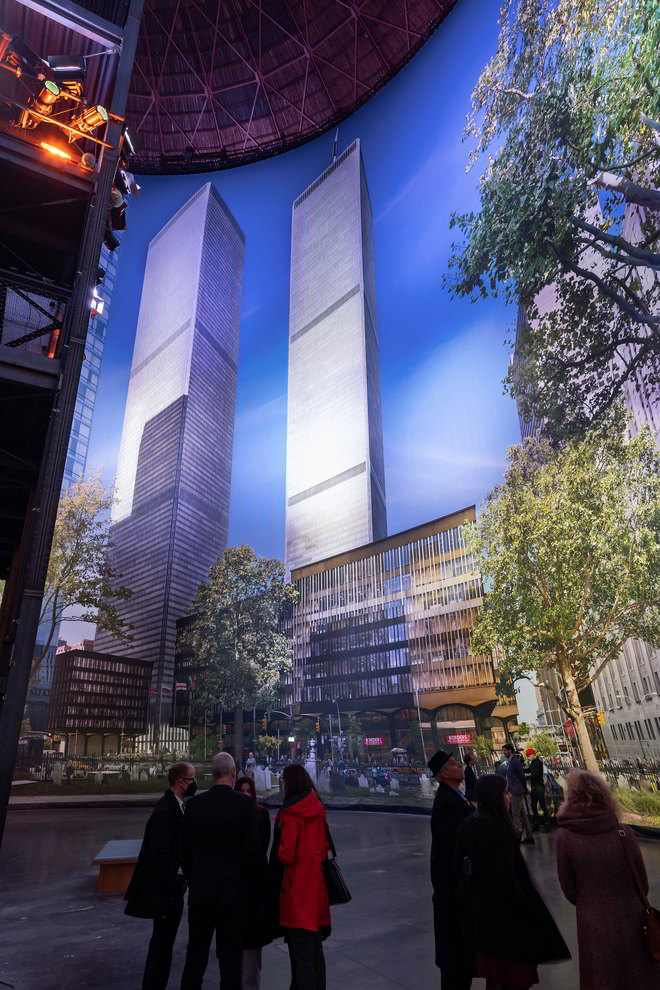
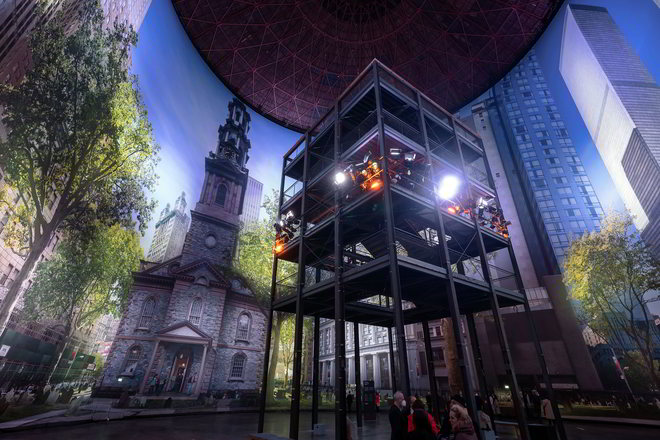

ÖÖ: Zur räumlichen Organisation von 9/11: Das Panorama ist die Endstation der Ausstellung; davor kommen Installationen, u. a. „Es werde Geld“ und „Der Krieg beginnt im Wohnzimmer“. Nach welchen Kriterien haben Sie diese Themen ausgesucht? Sie haben eine Abfolge von Tragik geladenen Stationen und dann kommt der Höhepunkt, ein strahlend sonniges Panorama mit dem World Trade Center und Umgebung …
YA: Am Anfang ist das Warum der wesentliche Teil des Ganzen. Bei 9/11 habe ich gefragt, warum wir in der Wahrnehmung von Dingen in dieser Welt so abgebrüht sind. Heute passiert weltweit so viel Grausames. Wir sehen es in den Nachrichten, machen den Fernseher wieder aus, und dann essen wir unser Abendbrot. Die Normalität in dieser Grausamkeit passiert jeden Tag. Ist das jetzt was Böses, weil wir so böse sind? Nein, weil wir in dieser Normalität nur halbwegs unser Leben organisieren können. Und wenn es weit genug weg ist, blenden wir es aus.
Jeder, der halbwegs das Alter hat, weiß, was damals bei 9/11 passierte und was er an dem Tag gemacht hat. Wir sehen in der Chronologie der Abfolge, was daraus entstand. Eigentlich müssten wir uns heute doch die Frage stellen, ob wir etwas hätten tun können. Wenn wir dann z. B. die Installation „Der Krieg beginnt im Wohnzimmer“ anschauen, sagen wir‚ ich habe da doch auch am Fernseher gesessen. Auch ich habe die Rede von Bush „Krieg gegen den Terror“ gehört, aber nicht sofort reagiert. Jetzt würde ich die Frage in den Raum werfen, wie man auf einen grausamen Anschlag sofort mit einer Kriegserklärung reagieren kann, denn der Krieg bedeutet 1000-mal mehr.
Nach der Klärung des Warums ist es ein langer Weg bis hin zur Umsetzung. Ich beginne mit Skizzen und berate mich mit Mathias Thiel, mit dem ich die Ausstellungen realisiere. Dann sprechen wir mit dem Team. Wir haben Themen gesucht, die um Fakten kreisen, die wir vielleicht gar nicht vor Augen hatten, die aber, wenn man etwas überlegt, uns fragen lassen: Kann das wirklich sein?
Ich gebe Ihnen ein Beispiel. Ich höre die Nachrichten. Der Sprecher verkündet: Der Krieg gegen den Terror hat 6 Billionen Dollar gekostet. Ich erstarre: 6 Billionen – das ist eine Zahl, die wir uns nicht vorstellen können! So kam es zu der Idee, diese Zahl zu simulieren und damit begreifbar zu machen, was 6 Billionen eigentlich bedeutet. Wir haben uns entschieden, zwei Türme zu bauen, die den Zwillingstürmen ähnlichsehen – dargestellt in Gold. Sie sind 22 Meter hoch und stehen mitten im Gasometer. Diese imposanten Gebilde demonstrieren in Größe und Umfang nur 1/10 des Betrages, den der Krieg gekostet hat. In den vergangenen 20 Jahren sind 40 Billionen Dollar für Kriege und Waffen weltweit ausgegeben worden. Wenn Sie das mal sacken lassen!
Dann haben wir überlegt, wie man die vielen Toten berührend inszenieren kann. Es gab viele Ansätze. Zum Schluss entschieden wir uns, Striche auf den Boden zu malen, so wie im Gefängnis „1 2 3 4, Querstrich 5“. Das ganze Team hat zwei Tage lang den Boden mit Strichen bemalt – Hunderttausende Striche. Das ist nicht die Menschenmenge von einer Million, die nach der Statistik durch die Kriege danach umgekommen ist, aber die Striche stehen stellvertretend für sie. [Laut des Watson Institute der Brown University kamen nach 9/11 mehr als 929.000 Menschen durch direkte Kriegsgewalt ums Leben, und die Nachwirkungen des Krieges führten zu einem Vielfachen davon; Anm. d. V.] Die rund 3000 Toten des Anschlags wurden handschriftlich geschrieben, wie im New Yorker Denkmal mit allen Namen auf einer großen Tafel.
Zudem gibt es eine Chronologie mit Ereignissen, die in den vergangenen 20 Jahren passiert sind: für jedes Jahr eine Auflistung. Hier sind nicht nur die Grausamkeiten zu finden, sondern z. B. auch die Fußballweltmeisterschaft. Man sieht die Liste und denkt‚ oh ja, da haben wir die Fußballweltmeisterschaft geschaut, aber in der Welt ist auch das und das passiert.

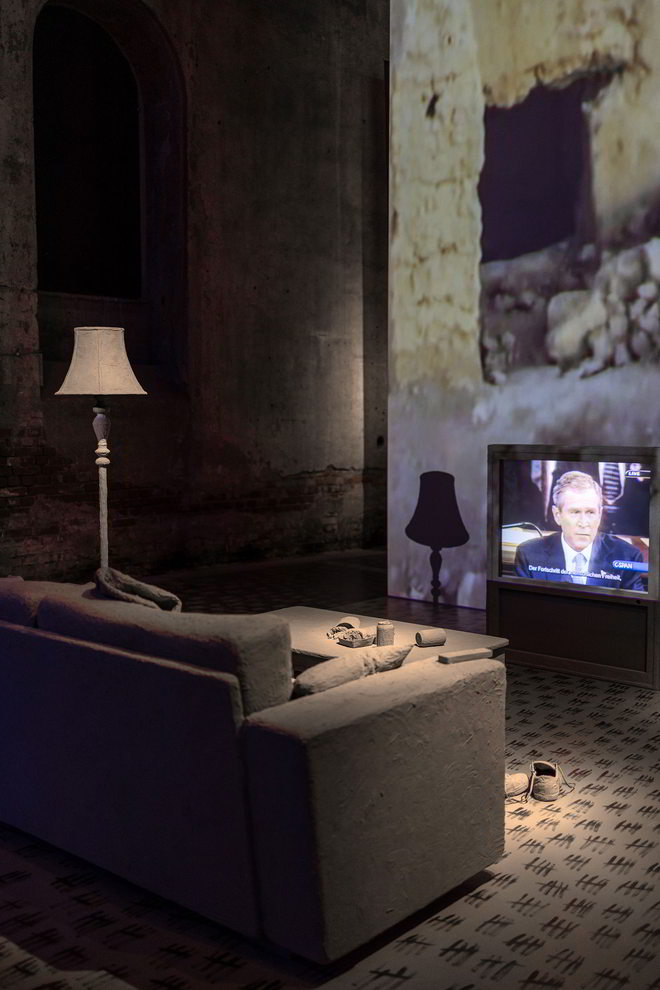
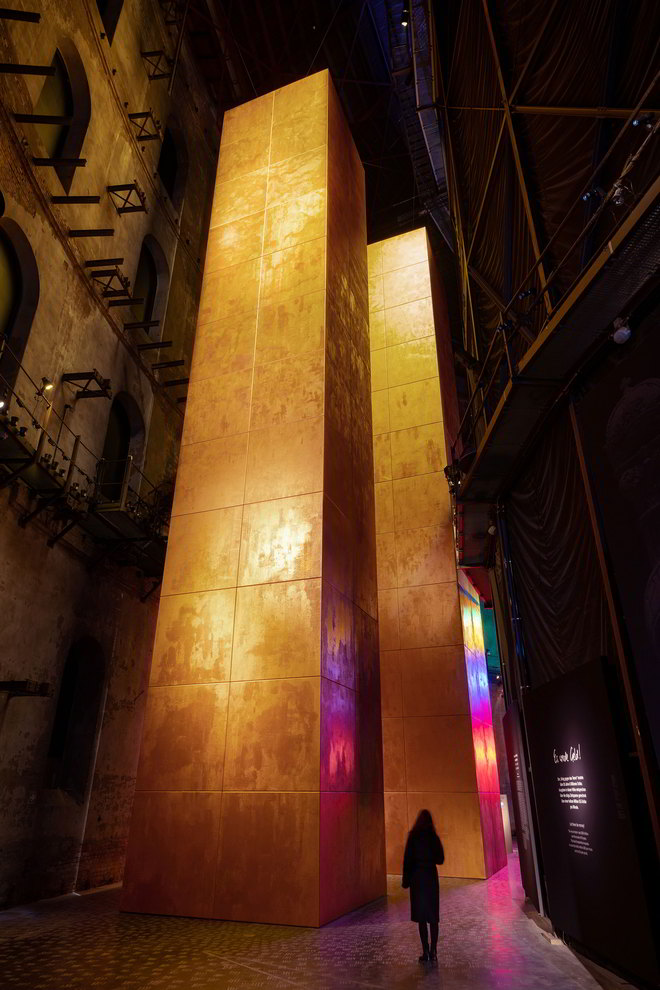
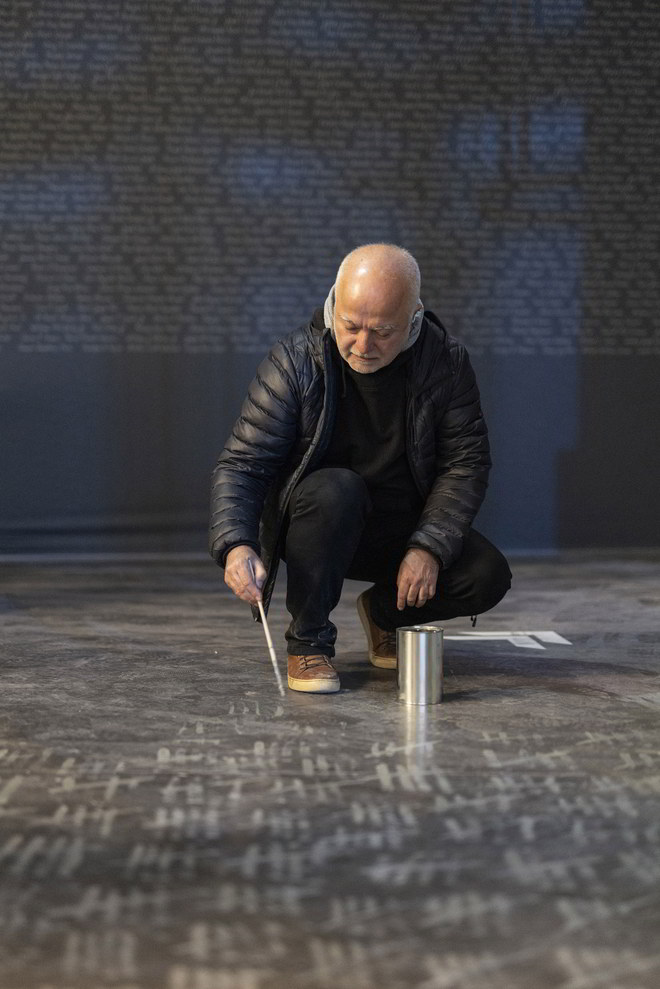
ÖÖ: Einige Worte noch zur Atmosphäre von 9/11: Sie sind ja auch Bühnenbildner und Ausstellungsarchitekt – man hat den Eindruck, diese Erfahrungen sind bei diesem Projekt besonders spürbar, siehe die szenenhaften Installationen. Inwiefern ist „Stimmung“ bei Ihren Panoramen wichtig?
YA: Das Panorama ist ein sehr interdisziplinäres Medium und sie ist – auch in dieser Ausstellung – keine Kulisse, weil sie nicht im Hintergrund steht. Besucher meiner Panoramen können mir noch Jahre später erzählen, was sie erlebt haben. Es passiert etwas sehr Körperliches, das in Erinnerung bleibt. Klaus Honnef, ein Kunstkritiker, hat mal in einem Interview gesagt, dass das Panorama eine der wenigen ihm bekannten Kunstformen ist, bei der man sich durch die Kunst bewegt, was ihn total fasziniert. Beim Panorama muss man sich bewegen. Es ist ein ganzheitliches Erlebnis, das man keiner Kategorie zuordnen kann. Natürlich gehört auch das Filmemachen dazu. Natürlich ist da auch Theater drin. Trotzdem ist eine Klassifizierung schwierig für mich. ♦
Yadegar Asisi on his panorama „9/11“ and how he thinks about the world
The subject of the current exhibition by Yadegar Asisi at the Panometer Leipzig is, as usual, overwhelming: NEW YORK 9/11 – War in Times of Peace. The artist talks about its background and details, his career and asks why we are so hardened today.
Özlem Özdemir: Your panorama themes often revolve around darker moments of humanity. There are battles, environmental threats, catastrophes or other historical breaks like Leipzig 1813, Luther 1517 and Titanic. New York 9/11 – War in Times of Peace, the current exhibition at the Panometer Leipzig, about the 11 September 2001 attacks on the World Trade Center and their global impact. Do you prefer the grand and grave to make your panoramas more convincing and enticing for the audience, or are there other reasons?
Yadegar Asisi: Many who have not seen a panorama think it is because of the grandness that one is overwhelmed. But no, this grandness fades away within minutes. When I first got involved with the subject of panorama, I didn’t know on what I was committing. I would never have thought that such an opportunity – tailor-made for me – existed. It evolved that way, and so did the themes. The success with Everest is a perfect example. With this project, I had the almost childish approach „the biggest mountain in the world needs the biggest panorama“. It then became the first large-scale panorama.
That led to the idea of reviving the Panorama by addressing the question: What can it actually do today? I locked myself away for a few months and looked for themes that particularly interested me. It was not about the big picture but about the becoming and passing away of this world. It is about the contemplation of the human being in relation to this world.
ÖÖ: So your themes don’t arise spontaneously or just come to you, but you reflected, from the start, on your range of themes?
YA: Yes. My reflections brought me to four main themes: City views, which usually depict not only the city itself but the place in the context of the respective society and contemporary history works, i.e. images of collective memory and then the nature images, which show the emotional power of natural spaces and finally, the panorama as an object of perception that stands exclusively for itself. I am constantly expanding the programme. In choosing my themes, I rely a lot on my feeling.
ÖÖ: You studied painting and were a master student of Professor Klaus Fußmann, a well-known landscape painter and representative of the New Objectivity. He made the ceiling painting Wolkenzug (Cloud-Drift; trans. by the editor) in the Spiegelsaal of the Hamburg Kunstgewerbemuseum. To what extent was Fußmann significant for you?
YA: I studied architecture in Dresden from 1973 to 1975 and worked in an architectural office. Because there was no residence permit for graduates in the BRD at that time, I went on to study painting. [Asisi, the son of Persian parents, was born in Vienna during his mother’s flight from Iran to Europe. His father, a communist officer, was sentenced to death by the Shah. He spent his childhood and school years in Halle (Saale) and Leipzig. In 1978, when he had finished his architecture studies, he was ordered to leave the GDR within a month. But since he was not allowed to go to Iran either, he wanted to go to West Berlin. He was arrested at the border on the charge of illegal entry with a Persian passport. He could only stay as a student. That’s how he ended up studying painting at the Hochschule der Künste in Berlin; editor’s note]. Studying painting was very important to me as a horizon giver. That’s how I came to Fußmann. I always liked him as a painter. He had told me things that were very, very important to me.
Recently, I took Fußmann through two panoramas. He confided in me that I was one of his students who was very memorable to him. It fascinated him how I was going my own way. He always pushed through his painting – independently of galleries. Because they would have let him paint only still lifes in the beginning since that sells well; he always wanted the landscape, the figurative art, and he never let them take that away from him.
It was also crucial for me to find an independent path. The fact that I succeeded is a magnificent providence. Klaus Fußmann was a terrific encounter for my development. I always liked his approach as a painter immensely, and our conversations were valuable to me. I hope he will live for a long time. It was also a good coincidence that I ended up in architecture, as ultimately, the interplay between architecture and painting has brought me to where I am now. And I wouldn’t want to miss either of them.
ÖÖ: Talking of architecture: In 1982, your office Brandt-Asisi-Böttcher received a Mies van der Rohe Award for the Berlin maglev terminus. A few words about Andreas Brandt: His work was characterised by travelling and drawing, and those activities are predominant in your work, too. For example, you travelled to Turkey for Pergamon or the Amazon region for Amazonia. You draw a lot and combine drawing with digital techniques. How much of an influence did Brandt have on you?
YA: It’s nice that you ask me about Andreas Brandt. I came from the GDR, and he was looking for someone skilled in spatial drawing. I have to add back then, few people were able to do that. He was working on a large-scale project in Unna that he wanted to push forward. I had an office and needed money for my own projects. So I drew for architects from Germany and abroad, and that’s how I met Andreas Brandt. He was a brilliant graphic artist and made beautiful drawings – but only in view because he couldn’t draw spatially.
And so he, an experienced architect, and I, a young hothead, came together. We immediately had a connection with each other. Right at the first meeting, we decided to open an office together. At the beginning of the 1980s, there was no getting around Brandt-Asisi-Böttcher. We won competitions, and that’s how we came to Kassel Station.
Böttcher was the implementer. Brandt and I constituted the workshop – we sat together for nights and tossed ideas back and forth. I always found this to be an ideal combination, i.e. the philosopher Brandt, the hot-headed and inexperienced, but maybe also blessed with a bit of talent Asisi and the real expert Böttcher. But they were both 20 years older than me. We had generational conflicts, and I didn’t want to deal with them. So we parted ways.After the discord of that time, we met again, Andreas Brandt and me. Unfortunately, he died suddenly in 2014. That really hurt a lot. He was such an important figure on my path. Then came the professorship for architecture and I was no longer a builder.
ÖÖ: When 9/11 happened, you were still teaching Free Representation in Berlin. In 2002 you entered Ground Zero to develop a panorama for Daniel Libeskind. What impressions have you incorporated into the work you did then and perhaps also today? How did the contact with Libeskind come about? To what extent has all this influenced your current project in Leipzig?
YA: Daniel Libeskind and I knew each other quite early on. Like me, he stayed in Berlin. And since I drew a lot, people knew me. At some point, Libeskind’s office approached me, and we did several projects together. He won two big projects, the Victoria Albert Museum in London and 9/11. [Daniel Libeskind was appointed master planner for the redevelopment of Ground Zero in 2003; ed.] I don’t want to suggest that it was because of my drawings, but I think they helped.
Libeskind said: „The other offices have a lot of money, I don’t have that. Can you imagine what you can do there?“. I advised him to stand in the hole of Ground Zero and then express the feeling you get by doing that. And the only thing that would be suitable for this, I said, is a panorama. But the New York jury rejected a panorama. I proposed a film instead. I stood in the middle of the hole and moved the camera to make it look like you were spinning in actual space.
The collaboration with Libeskind was decisive for me because once he had become the winner, I started to see my name pop up. That was in the run-up to the first large-scale panorama, Everest, which I wanted to do in Leipzig. When it was in the press that Libeskind was the winner and Asisi was part of it, my position was more solid, and the Stadtwerke Leipzig decided to go for it. Daniel Libeskind and the competition were a door opener. I don’t know if I would have got this far without it.
It’s interesting: at that time, I didn’t have the impulse to do something of my own on 9/11. But it was definitely very moving to stand in this hole the whole world was talking about. Then, as the years have gone by, I’ve come to think more and more, „What’s happening here right now?“ When it comes to terrorism, people always talk about the act of terrorism and how cruel it is. I agree with that a hundred times. But how does this terrorism come about? People rarely speak about this. The war that followed the terror shook me because it, among others, reminded me of my own family history. I made the first sketches of 9/11 at the end of the ’10s.
And the current 9/11 panorama is a picture of the situation at that time. You face the two skyscrapers, and the church clock shows 8:41 a.m. – five minutes before the first attack. I wanted to create a condition that makes people ask questions they didn’t ask before. With the panorama, I found a medium that fits my way of thinking about the world.
ÖÖ: On the spatial organisation of 9/11: The Panorama is the final stop of the exhibition; before that, there are installations, including „Es werde Geld“ („Let there be money“) and „Der Krieg beginnt im Wohnzimmer“ („The war begins in the living room“). What criteria did you use to select these themes? You have a sequence of tragedy-laden stations, and then comes the climax, a radiant sunny panorama with the World Trade Center and surroundings …
YA: In the beginning, the why is the essential part of the whole. With 9/11, I asked why we are so hardened in our perception of things in this world. Today, so much cruelty is happening around the world. We see it on the news, turn the TV off again, and then eat dinner. The normality in this cruelty happens every day. Is that something evil now because we are so evil? No, because we can only halfway organise our lives in this normality. And when it’s far enough away, we block it out.
All people of a certain age know what happened on that day of 9/11 and what they did back then. We see in the chronology of the sequence what came out of it. Actually, we should ask ourselves today whether we could have done something. When we look at the installation “ Der Krieg beginnt im Wohnzimmer“ („The war begins in the living room“), for example, we say, „I was sitting in front of the television there, too. I too heard Bush’s „war on terror“ speech, but did not react immediately. Now I would ask how it is possible to respond instantly to a cruel attack with a declaration of war because the war involves 1000 times more.
After clarifying the „why“, it’s a long way to implementation; I start by doing sketches and consulting with Mathias Thiel, with whom I realise the exhibitions. Then we talk to the team. We looked for themes that revolve around facts that we perhaps didn’t even have in mind, but which, if you think about it a bit, make us ask: Can this be true?
I’ll give you an example. I am listening to the news. The newsreader announces: The war on terror has cost 6 trillion dollars. I freeze: 6 trillion – this is something we can’t imagine! So we came up with the idea of simulating this number and thus making it comprehensible what 6 trillion actually means. We decided to build two towers that look like the twin towers – represented in gold. They are 22 metres high and stand in the middle of the Gasometer. These imposing structures demonstrate in size and scale only 1/10 of what the war cost. In the past 20 years, 40 trillion dollars have been spent on wars and weapons worldwide. Let that sink in!
Then we thought about how to stage the many dead in a touching way. There were many approaches. Finally, we decided to paint lines on the floor, like in prison „1 2 3 4, cross line 5“. The entire team painted the floor with lines for two days – hundreds of thousands. That is not the crowd of one million people who, according to statistics, died due to the wars that followed, but the lines are representative of them. [According to Brown University’s Watson Institute more than 929,000 people died from direct war violence after 9/11, and the aftermath of the war led to many times that number; ed. note]. The roughly 3,000 dead in the attack were handwritten, just as in the New York memorial with all the names on a large plaque.
Furthermore, we give a chronology of events happened in the past 20 years: a listing for each year. Here you can find not only the atrocities but also, for example, the World Cup. You look at the list and think: Oh yes, we were watching the World Cup, but this and that also happened in the world.
ÖÖ: Some more words about the atmosphere of 9/11: You are, after all, also a set designer and exhibition architect – one gets the impression that these experiences are particularly palpable in this project, see the scenic installations. To what extent is „atmosphere“ important in your panoramas?
YA: The panorama is a very interdisciplinary medium, and it is – like in this exhibition – not a stage set because it is not in the background. Visitors to my panoramas can still tell me years later what they experienced. Something very physical happens that remains in the memory. In an interview, Klaus Honnef, an art critic, once said that the panorama is one of the few art forms he is familiar with in which you move through the art, which totally fascinates him. With the panorama, you have to be in motion. It is a holistic experience that you cannot assign to any category. Of course there is filmmaking in there, too. Of course there is also theatre in it. Nevertheless, it is difficult for me to classify it.
TRANSLATION BY ÖZLEM ÖZDEMIR



